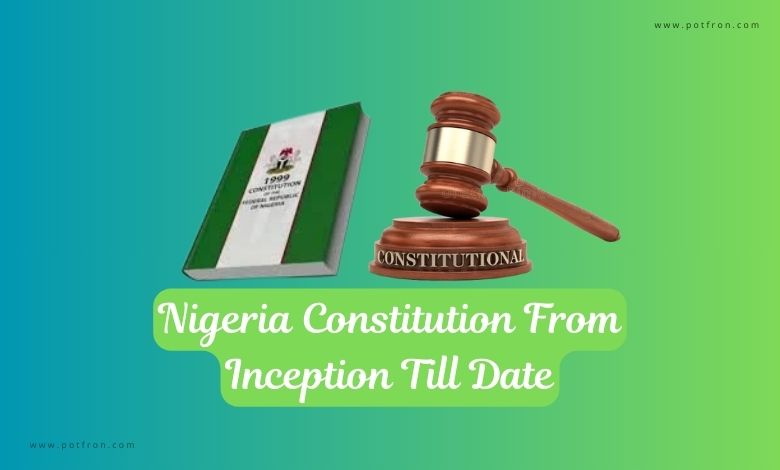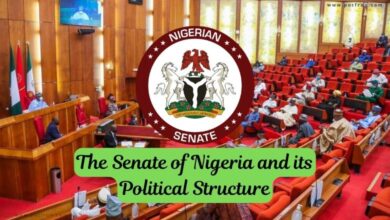Nigeria Constitution From Inception Till Date
Nigeria Constitution, Constitution of Nigeria

The Nigeria Constitution is the supreme legal document that outlines the structure of government, rights of citizens, and the powers and responsibilities of institutions in Nigeria.
The history of Nigeria’s constitutional development reflects its evolution as a nation, from pre-colonial indigenous governance systems through colonial administration, to post-independence adjustments. The Nigerian Constitution has served as the foundational legal framework for governance, that outlines the structure of government, the rights and responsibilities of citizens, and the distribution of powers.
Pre-Colonial Governance
Before the advent of colonial rule, Nigeria was home to diverse ethnic groups with distinct governance structures. These systems included the centralized empires of the Hausa-Fulani in the north, the Yoruba kingdoms in the west, and the decentralized Igbo communities in the east. Governance was typically based on customs, traditions, and unwritten laws tailored to local needs. While these systems varied significantly, they were largely cohesive and reflective of the social, economic, and cultural fabric of their respective societies.
Suggested read: Cabinet of Nigeria And its Presidential System
Read also: An Overview of Nigeria Political System
Colonial Era and the First Constitution (1861-1946)
Colonial rule in Nigeria formally began in 1861 with the annexation of Lagos as a British colony. Over time, British administration expanded, and the need for a unified governance framework became evident.
The Clifford Constitution (1922)
The Clifford Constitution marked the first major step in constitutional development. Introduced by Governor Sir Hugh Clifford, it replaced the 1914 amalgamation framework that unified the Northern and Southern Protectorates. Key features included:
- The establishment of a Legislative Council for the Southern Provinces.
- Limited representation, with four elected seats for Lagos and Calabar.
- Exclusion of Nigerians from key administrative roles.
The Clifford Constitution laid the groundwork for political engagement, as evidenced by the formation of political groups such as the Nigerian National Democratic Party (NNDP).
The Richards Constitution (1946)
The constitiution was approved in 1946 and was called the Richards Constitution after Governor-General Sir Arthur Richards, who was responsible for its formulation. The Richards Constitution was introduced to address criticisms of the Clifford framework. It sought to promote greater participation by Nigerians and regional autonomy. Key elements included:
- Regional Councils for the North, West, and East.
- A central legislative council to address national issues.
- Inclusion of traditional rulers and elites in governance.
The Richards Constitution acknowledged Nigeria’s diversity by implementing a federal system with regional powers. While it accurately reflected the country’s circumstances, it ultimately reinforced regionalism rather than fostering political unity. It was abolished in 1950 in response to demands for increased autonomy. However, the Richards Constitution was criticized for its lack of widespread consultation and limited electoral representation.
Also read: 100 Popular Facts About Nigeria
Toward Independence: 1950s Constitutional Reforms
The post-World War II era ushered in increased political awareness and agitation for self-determination. This led to significant constitutional reforms aimed at preparing Nigeria for independence.
The Macpherson Constitution (1951)
It was named after Governor-General, John Stuart Macpherson and the constitution was notable for its consultative approach. In 1950, an inter-parliamentary conference in Ibadan drafted a new constitution, later named the Macpherson Constitution. It was implemented the following year.
The Macpherson Constitution established regional autonomy within a federal structure, forming a central government with a Council of Ministers. This framework promoted political engagement and encouraged the growth of political parties at the national level. It introduced key changes such as:
- A federal structure with regional legislatures.
- Expanded representation and indirect elections.
- Enhanced roles for regional premiers.
Despite these advances, tensions between regional and national interests became evident, as ethnic and regional divisions intensified.
The Lyttleton Constitution (1954)
The subsequent constitutional revision was introduced in 1954, known as the Lyttleton Constitution was named after Oliver Lyttleton, and it solidifying the federal system. It played a crucial role in Nigeria’s path to independence from Britain. Like the Richards Constitution, it also strengthened regional loyalties among Nigerians. The Lyttleton Constitution marked the formal introduction of federalism in Nigeria. It provided for:
- Greater autonomy for regions.
- A federal legislature with representatives from the regions.
- An independent judiciary.
This framework laid the foundation for Nigeria’s federal structure and was instrumental in managing the country’s ethnic diversity.
Recommended: Nigeria National Anthem and Its Frequently Asked Questions
The Independence Constitution (1960)
Nigeria’s first constitution as an independent nation was established through a British Order-in-Council and took effect on October 1, 1960, upon gaining independence. Under this constitution, Queen Elizabeth II remained the ceremonial head of state as the Queen of Nigeria, with Nnamdi Azikiwe serving as her representative in the role of Governor-General. On October 1, 1960, Nigeria attained independence, and the Independence Constitution came into effect. It Key features included:
- A parliamentary system of government modeled on the British Westminster system.
- A Governor-General representing the British monarch as the ceremonial head of state.
- A bicameral legislature comprising the Senate and House of Representatives.
- Recognition of regional governments with significant autonomy.
While the Independence Constitution symbolized a significant achievement, it also inherited the challenges of managing a diverse and polarized society.
The Republican Constitution (1963)
Nigeria’s second constitution as an independent nation eliminated the monarchy and established the First Nigerian Republic. It took effect on October 1, 1963, marking the third anniversary of independence. Nnamdi Azikiwe then became Nigeria’s first President under this constitution, which was modeled after the Westminster system. The Republican Constitution replaced the Governor-General with a President as the ceremonial head of state. Other notable changes included:
- Judicial independence, with the Supreme Court becoming the apex court.
- A reaffirmation of federalism, with continued regional autonomy.
Despite these changes, political instability and regional rivalries persisted, which resulted in the first military coup of 1966.
Military Rule and Constitutional Suspensions (1966-1979)
The military’s intervention in 1966 led to the suspension of constitutional governance. Subsequent regimes introduced decrees that significantly altered the constitutional framework.
The 1979 Constitution
The 1979 constitution marked the beginning of the Second Nigerian Republic, replacing the Westminster system with a U.S.-style presidential system featuring direct elections. To prevent the challenges faced by the First Nigerian Republic, it required political parties to be registered in at least two-thirds of the states. Additionally, it created a Nigerian Cabinet, ensuring that each state had at least one representative, thereby promoting a sense of “federal character” across the country. It key features included:
- A shift to a presidential system of government, inspired by the United States.
- Separation of powers among the executive, legislature, and judiciary.
- Provisions for fundamental human rights.
- Creation of new states to address demands for regional representation.
While the 1979 Constitution sought to address the flaws of previous frameworks, its implementation was hindered by corruption and political inefficiency, leading to another military takeover in 1983.
Also read: Nigeria Coat of Arms And its Full Meaning
The 1999 Constitution: A New Democratic Era
After years of military rule, Nigeria returned to democracy in 1999 with the promulgation of the current constitution, which was largely based on the 1979 Constitution.
The 1993 constitution established the Third Nigerian Republic and was intended to restore democratic governance, but it was never fully implemented. The military remained in control until May 1999, when power was transferred to an elected president. The 1999 constitution then established the Fourth Nigerian Republic as a democratic federation, and it remains in effect today.
This constitution defines Nigeria’s national capital, 36 states with their capitals, and 774 local government areas. It outlines the structure of government, including the legislative, executive, and judicial branches, specifying their responsibilities and the distribution of power between federal and state authorities. Legislative authority is vested in the National Assembly, which consists of two chambers: the Senate and the House of Representatives. The constitution grants the National Assembly the authority to enact laws for the “peace, order, and good government of the Federation.”
Key Features of the 1999 Constitution
- Federal Structure – Nigeria operates as a federal system, dividing power between the 36 states and the Federal Capital Territory.
- Democratic Governance – It establishes a presidential system, where the President is both the Head of State and Government.
- Fundamental Rights – Chapter IV enshrines fundamental human rights, including freedom of speech, religion, and association.
- Legislative Powers – The National Assembly, made up of the Senate and House of Representatives, has the power to make laws.
- Judicial Independence – The judiciary ensures the rule of law and has the power of judicial review.
Challenges of the 1999 Constitution
The 1999 Constitution has faced criticism for issues such as:
- Centralization of power, undermining true federalism.
- Ambiguities in revenue allocation and resource control.
- Limited inclusivity in its drafting process.
Constitutional Amendments and Reforms
Efforts to amend the 1999 Constitution have been ongoing, with notable reforms addressing electoral processes, gender equality, judicial autonomy and so on. However, achieving consensus on major amendments remains difficult due to political and regional interests.
Download Nigeria 1999 Constitution
Download Nigeria Nigeria 1999 Constitution As Amended




